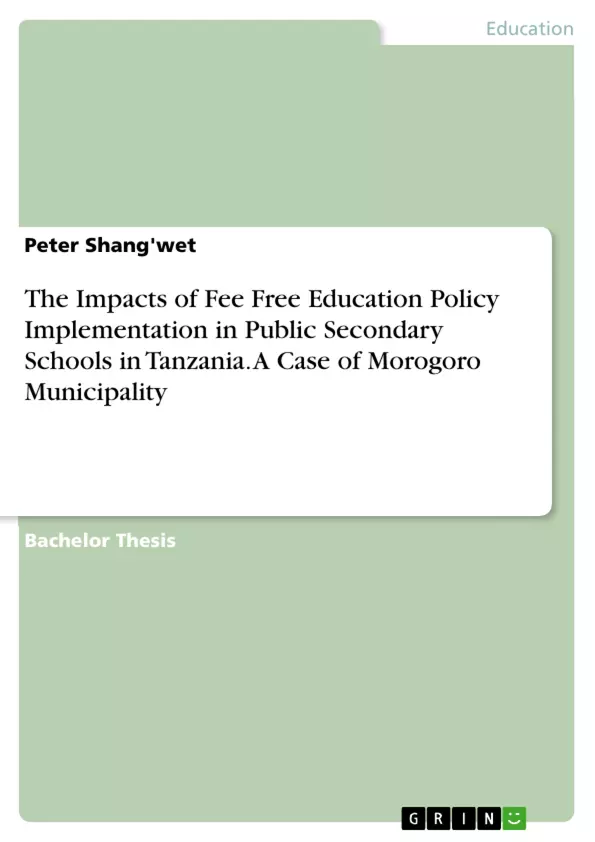This study is guide by the following research questions: Do stakeholders understand the essence FFE policy implementation?
Are there any challenges facing the implementation of fee free education?
This study investigated the impacts of fee free education policy implementation in public second-ary schools, a case of Morogoro Municipality, Morogoro region in Tanzania. The study was guided by two specific objectives including: investigation of stakeholders’ understanding on the essence of fee free education and evaluation of the challenges encountered during the implementation of fee free education policy in Tanzania. The study involved a sample of 45 participants. Two data collection methods were included i.e. questionnaires and interviews. Statistical Packages for Social Science (SPSS) version 20 employed in data analysis for quantitative analysis. Analyzed data are then presented in different formats such as graphs, charts and tables.
Education is one of the most important sector in any nation. It is the responsibility of a government to set and launch national education policy and participate in setting up international policies on education. Countries have been investing much in education especially primary and secondary education, regarded as a basic education. Since independence 1961, Tanzania has made various efforts in broadening the education service to her people. This is to ensure that education service is accessible to nearly every Tanzanian. In Tanzania, the first effort of Fee Free Education was instigated in 1963 to ensure that majority of Tanzanians get education and to remove the enrolment gap between poor and rich households. Therefore, government financed and provided free education from primary to university level. International efforts on ensuring free education for all also guided Tanzania towards implementation of free education. World Conference on Education for All (EFA) held on 1990 at Jomtien in Thailand rearticulated the desire of achieving Universal Primary Education by 2000.
Table of Contents
- Introduction
- Background of the Study
- Statement of the Problem
- Objectives of the Study
- General Objective
- Specific Objectives
- Research Questions
- Significance of the Study
- Scope of the Study
- Limitations of the Study
- Definition of Terms
- Literature Review
- Research Methodology
- Research Design
- Study Population and Sampling Techniques
- Population of the Study
- Sampling Techniques
- Data Collection Instruments
- Questionnaires
- Interviews
- Data Collection Procedures
- Data Analysis Techniques
- Results and Discussions
- Socio-Economic Background of Respondents
- Understanding of the Fee-Free Education (FFE) Policy
- Teachers' Understanding of the FFE Policy
- Students' Understanding of the FFE Policy
- Parents' Understanding of the FFE Policy
- Implementation of the Fee-Free Education (FFE) Policy
- Challenges in the Provision of Fee-Free Education
- Challenges as Perceived by Teachers
- Challenges as Perceived by Students
- Challenges as Perceived by Parents
- Impacts of the Fee-Free Education Policy
- Impacts on Teachers
- Impacts on Students
- Impacts on Parents
- Suggestions for Improving the FFE Policy
- Teachers' Suggestions
- Parents' Suggestions
- Summary, Conclusion and Recommendations
- Summary of Findings
- Conclusion
- Recommendations
Objectives and Key Themes
This study aims to investigate the impacts of the Fee-Free Education (FFE) policy implementation in public secondary schools in Tanzania, focusing on schools in Morogoro Municipality. The study explores how the policy has been understood, implemented, and its impact on teachers, students, and parents. The key themes investigated in this study include:- Understanding of the FFE policy among teachers, students, and parents.
- Challenges faced in the implementation of the FFE policy.
- Impacts of the FFE policy on teachers, students, and parents.
- Suggestions for improving the FFE policy.
Chapter Summaries
The introduction provides a comprehensive overview of the research, outlining the background, problem statement, objectives, research questions, significance, scope, limitations, and definition of key terms.
The literature review chapter delves into existing research and theoretical frameworks related to the FFE policy, drawing on relevant scholarly literature and prior studies.
The research methodology chapter meticulously describes the methods employed in the study, including the research design, population, sampling techniques, data collection instruments, procedures, and analysis methods.
The results and discussion chapter presents the findings of the study, analyzing data collected through questionnaires, interviews, and observations. It examines the understanding of the FFE policy, challenges faced in its implementation, and the impacts on different stakeholders.
Keywords
The study focuses on the Fee-Free Education (FFE) policy in Tanzania, specifically its implementation and impact. Key terms and concepts explored include education policy, public secondary schools, teacher perspectives, student experiences, parental involvement, challenges, impacts, and policy improvement.- Quote paper
- Peter Shang'wet (Author), 2020, The Impacts of Fee Free Education Policy Implementation in Public Secondary Schools in Tanzania. A Case of Morogoro Municipality, Munich, GRIN Verlag, https://www.grin.com/document/993594



